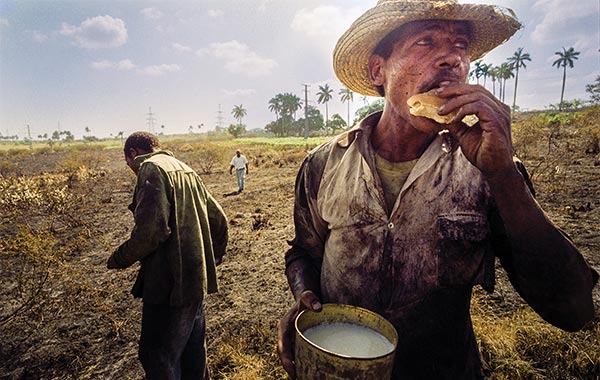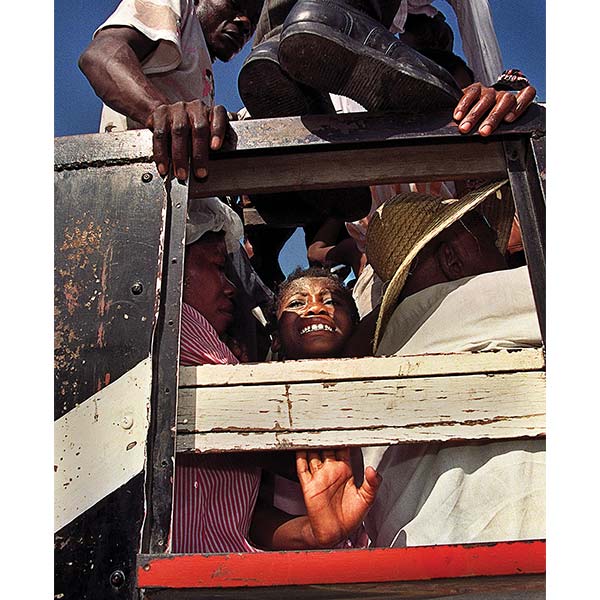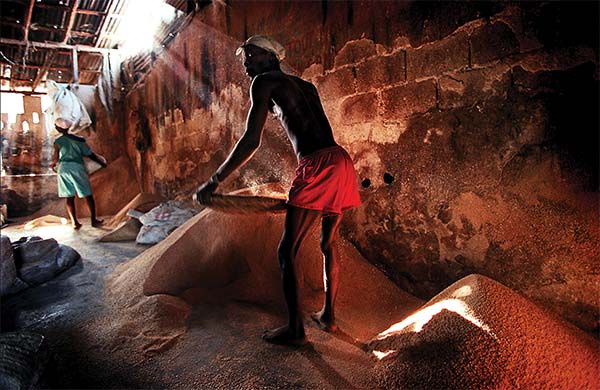Subtotal: $
Checkout-

The Greatest Thing Since Sliced Bread
-

The Ground of Hospitality
-

Beating the Big Dry
-

Cows and Elephants
-

At the Welcome Table I
-

At the Welcome Table II
-

Love Is Work
-

How Shall We Farm?
-

Why Yemen Starves
-

Digging Deeper: Issue 20
-

Cloth and Cup
-

Level
-

Editors’ Picks Issue 20
-

The Necessity of Reverence
-

A Book to End All Walls
-

Edna Lewis
-

The Dead Breed Beauty
-

Table Fellowship
-

Covering the Cover: The Welcome Table
-

Restoring a Creek
-

What I Stand For Is What I Stand On
-

Feasting in Kurdistan
-

The Birthday Party at the End of the World
-

From Farm to Feast
-

Readers Respond: Issue 20
-

Family and Friends: Issue 20
-

Streams in the Desert
-

The Boy and the Bull

The father of a friend used to tell her, as she enjoyed what he considered a bit too much food, that she was slowly digging her grave with her teeth. It’s not an original thought. Others have said it before him and will continue to say it after. As my friend and I used to reply to her father and others who echoed him, if not with the same words but the same sentiment, we know.
I often think of this supposed oral grave digging when I am with people for whom food is not an indulgence, people for whom there is no excess food, people for whom food seems dangerous. In the immigration detention centers that I have visited, for example, the subject of food often comes up. Many of the detainees see the terrible food they are fed at the most inconvenient hours – sometimes at four in the morning for breakfast and four in the afternoon for dinner – as yet one more way of punishing them.
Some were forced to sleep on the floor, but the food felt like the most humiliating torment.
The food would neither “stay up nor down,” one woman told me fourteen years ago when I met her in the South Florida hotel that had been turned into a holding facility for women and children who’d come to Miami by boat from Haiti. These women either vomited this food, or it gave them diarrhea. Six of them lived in one hotel room. Some were forced to sleep on the floor, but the food felt like the most humiliating torment. Not only did these women have no control over what they were putting in their bodies, but it was also making them sick, and the sickness was further dehumanizing them.
During my teenage years, in the early 1980s, my parents used to take me along with my father’s deacon group to visit Haitian refugees and asylum seekers at a detention center near the Brooklyn Navy Yard. The topic of food came up then as well. Back then, the men believed that hormones in the detention center food were making them grow breasts, a condition known as gynecomastia. “They’re trying to make us into women, so we can be more docile,” one man had told my father during one of our visits to the Brooklyn detention center.
In October 1987, thirty Haitian men who had been detained at Miami’s Krome Detention Center filed a civil suit against the federal government claiming that they’d developed gynecomastia while at Krome. The only thing the men detained in Brooklyn and the men detained in Miami appeared to have in common, besides being Haitian and being in detention, was the institutional food.
The lawsuit revealed that the gynecomastia might have been caused by the detention centers’ use of insecticides, particularly a type meant for animals, and Kwell, a harsh anti-scabies and lice cream, which was given to Haitian detainees to use daily as a body lotion. Other research, however, found clear links between diet and gynecomastia, and the men remained convinced that the detention center food had something to do with it. Despite all this, a jury found the government not liable.

André Chung, Cane Cutter, Havana, Cuba Reproduced by permission from Andre Chung
Meals eaten in desperation or under distress of course end up being memorable. The choice of pre-execution meals generates so much interest that these meals are often mentioned, along with the final words spoken by the dying, in postmortem press conferences. The most legendary final meal is the Last Supper, which is the great-great-great-grandfather of all final meals. We have no account of what else was consumed at the Last Supper besides unleavened bread and wine, which Jesus offered to his disciples – including the ones who would renounce and betray him, by saying, “Take, eat; this is my body.” Then, “Drink, this is my blood.”
Many of the men my father and his church friends visited in the Brooklyn detention center those many years ago were religious. As were some of the women I visited years later and have continued to visit whenever I am allowed into immigration detention centers. Many unaccompanied detained children carry with them a cross or a Saint Christopher medal, among other precious amulets, which are meant to protect them on their grueling journeys. Saint Christopher is said to have carried a small, vulnerable child across a raging river, a child who could have been any child in need, a stranger’s child who turned out to be the Christ Child. Saint Christopher, too, was a migrant who ended up being imprisoned, and eventually executed.
Many of the children crossing deserts and raging rivers these days also start out with some food that has been carefully cooked to sustain them at least part of the way. Then, for the rest of the journey, both parents and children must trust that they will somehow encounter food, either to buy or to be gifted, and water to drink to stay alive. This requires as much faith as hoping that there is a lamp beside a golden door, a door that is still open to “huddled masses yearning to breathe free.”

Carl Juste, Crushed, Port-au-Prince, Haiti Reproduced by permission from Carl Juste
One of the ways my immigrant parents tried to enmesh my brothers and me in American culture was to let us choose between eating pizza, fried chicken, or hot dogs on Friday nights after eating rice and beans, plantains, and other Haitian dishes every other night of the week. I never told them that I was already eating these “American” foods daily for lunch at school, because I feared that my parents, too, might feel that I was digging my grave with my teeth.
You must not seem too famished, too desperate, too empty.
My mother liked to tell my brothers and me that sak vid pa kanpe (empty sacks don’t stand) and se sa k nan vant ou ki pa w (only what’s in your belly is yours). And to that we would also reply, we know. She often told us these things right before we went to someone else’s house for lunch or dinner. The ultimate lesson in those maternal maxims and familial proverbs was to never show up somewhere too hungry. You never knew when they would be ready to feed you, and you must not seem too famished, too desperate, too empty when they do. And if by any chance your arrival at someone’s house happens to coincide with a meal to which you were not previously invited, you must refuse the food you are offered, even if you are starving. Otherwise it will seem as though you purposely showed up for that meal and that would make you seem calculatingly greedy, visye.
I think of all this, too, when I hear about people who have nothing in their stomach of their choosing, people who have to completely rely on others to feed them, people who have no choice but to swallow food they despise, and people who are fed against their will.
Lakhdar Boumediene was a prisoner in Guantanamo from 2002 to 2009. In 2017, he wrote in the New Republic about being on hunger strike there:
I am sometimes asked why I went on a hunger strike. Did you want to die? Had you given up? The answer is no. I stopped eating not because I wanted to die, but because I could not keep living without doing something to protest the injustice of my treatment. They could lock me up for no reason and with no chance to argue my innocence. They could torture me, deprive me of sleep, put me in an isolation cell, control every single aspect of my life. But they couldn’t make me swallow their food.
In July 2013, Yasiin Bey, the rapper and activist formerly known as Mos Def, agreed to be force-fed in a manner similar to the way prisoners on hunger strike were being force-fed at Guantanamo Bay. Bey was strapped to a feeding chair that resembled an electric chair. His hands and feet and head were placed in restraints. A nasal gastric tube was forced through his nose, down the back of his throat, and into his stomach, a process the US military called enteral feeding. As Bey wriggled and twisted in the chair – to whatever extent he could – tears ran down his face. He coughed. He grunted. He pleaded with his “jailers,” who sometimes pressed the weight of their bodies on his chest and stomach, to stop.
“Please, please, don’t,” he begged.
After a minute or so, he was squirming and struggling so much that the tube fell out. The jailers put him in a choke hold to further restrain him and only stopped when he spoke as himself, as Yasiin Bey, and said, “This is me. Please stop. I can’t do this anymore.” Then he broke down and cried.
Had Bey been an actual prisoner, his jailers wouldn’t have stopped until they were done force-feeding him. Those on hunger strike at Guantanamo Bay were fed like this twice a day, and for two hours each time. They then had a mask placed over their mouths while their bodies processed the liquid nutritional supplement, which was often Ensure. Back in their “dry” cells, which meant there was no water in those cells, they were observed closely to see if they were vomiting. If they vomited the supplement, they were returned to the restraining chair. Many prisoners urinated and defecated on themselves in the chair, as one might expect. The feeding tube, of course, makes it hard to breathe. Prisoners who were fasting during Ramadan, the Muslim holy month, were force-fed before dawn and after sunset. At the beginning of this year, detainees went on hunger strike in immigration detention centers in Texas, Miami, Phoenix, San Diego, and San Francisco, and were force-fed through nasal tubes on the orders of a federal judge. The force-feeding has led to constant vomiting and nosebleeds, according to family members.

Carl Juste, A Day’s Work, Port-au-Prince, Haiti Reproduced by permission from Carl Juste
Sometimes when a person dies under mysterious circumstances, when a person passes away suddenly with no previous sign of illness, for example, the elders in my family will say that this person was “eaten.” Yo mange li. They ate him. They ate her. The yo (they) who have done the eating is often a person or a group of persons of ill will who have deployed some destructive force to remotely kill someone else. We might never willingly offer ourselves to be eaten in this way, unless we are noble to the point of being sacrificial, or unless we feel we have no choice.
This is my body, this is my blood, this is my son, this is my daughter, this is my hope, this is my dream.
In the early 1990s, before it became a military prison where terrorism suspects are detained indefinitely, the Guantanamo Naval Base in Cuba was used to warehouse thirty-seven thousand Haitian asylum seekers who’d been intercepted by the US Coast Guard on the high seas after Haiti’s first democratically elected president, Jean-Bertrand Aristide, was overthrown in a military coup. And because HIV-positive immigrants were banned from entering the United States at the time, HIV-positive Haitian asylum seekers were held there for what must also have felt like an indefinite amount of time. Over two hundred HIV-positive Haitians, led by Yolande Jean, a mother of two and Haitian political activist, started a hunger strike on January 23, 1993, and continued the strike for ninety days. At that time Yolande Jean told American reporters: “We started the hunger strike so that this body could get spoiled and then the soul can go to God. Let me kill myself so my brothers and sisters can live.”
In a letter addressed to her family, particularly to her sons Hill and Jeff, while she was on hunger strike in Guantanamo Bay in 1993, Yolande Jean wrote:
To my family,
Don’t count on me anymore, because I am lost in the struggle of life. Hill and Jeff, you don’t have a mother anymore. Realize that you do not have a bad mother, only that life took me away. Good-bye my children. Good-bye my family. We will meet in another world.
Yolande Jean survived, but half of the HIV-positive hunger strikers died after they were finally released.
How many of us would have the courage to write a letter like that? And how many more mothers will have to write, or come close to writing, letters like this – how many must keep saying this is my body, this is my blood, this is my son, this is my daughter, this is my hope, this is my dream, this was my life, this is what my life was supposed to be, this is what I believed was going to be my death – how many of us must recite these pleas, these prayers, these laments, and these dirges, before we are brought to the table in communion, and are allowed to sit and eat in peace?
Already a subscriber? Sign in
Try 3 months of unlimited access. Start your FREE TRIAL today. Cancel anytime.






































